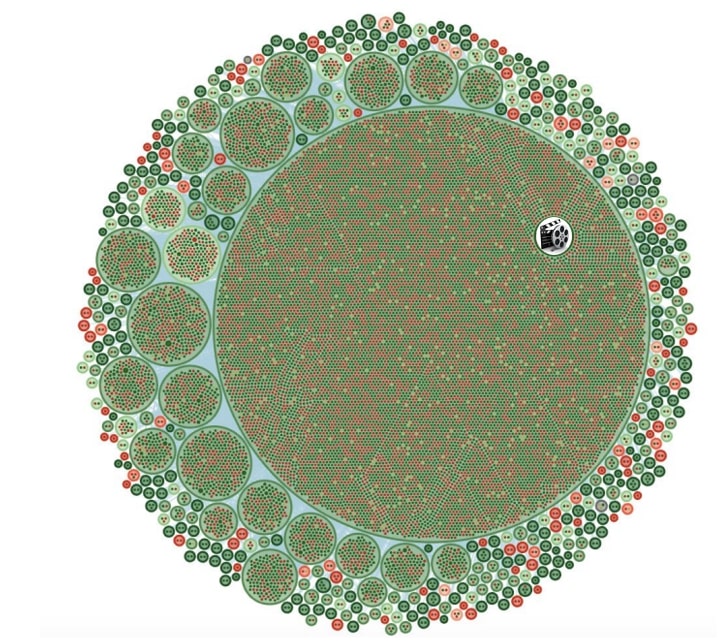When a major entertainment brand released its latest blockbuster, their social media team expected buzz – but what they got was a crisis. Shortly after the premiere, social media channels flooded with outrage – calls for boycott, false accusations against the cast, and worst of all, coordinated attack campaigns using viral hashtags.
What seemed like an authentic public backlash turned out to be anything but: The company found that it was actually facing a coordinated disinformation attack. The methods their team used to detect, mitigate and stop this crisis serve as a playbook for brand reputation.
TL;DR?
- Backlash erupted post-film release, with millions of negative mentions – but 76% of the negative activity came from fake accounts
- The brand used authenticity analysis to identify coordinated attacks and focus on real sentiment and authentic interactions
- With fast insight and strategy shifts, the corporate communication team stopped a potential crisis before it spiraled – and managed to improve the reputation of their brand.
Everyone Hated Your Movie – Or Did They?
It began overnight. The film premiered to packed theaters, and initial reactions were mixed. But within a few days, negative sentiment picked up. The brand woke up to thousands of angry mentions. The lead actor’s political views were under fire – but further examination uncovered that he didn’t make any new statement, and that his old tweets were being shared out of context, as well as false claims that he never actually made. Pushed together with criticism about the movie’s script, acting and special effects, general backlash started spreading, accompanied by calls for boycotts, inflammatory takes, and a growing narrative of outrage.
The communications team started suspecting this online negativity and hatred. The scale and pace felt orchestrated. They needed to know what they were really dealing with – and fast.
Clearing Out the Fake, Amplifying the Real
A deeper analysis revealed the truth: 76% of the backlash was coming from inauthentic accounts. These weren’t real viewers expressing real disappointment – they were fake profiles, coordinated to push a narrative that didn’t reflect actual audience sentiment.
What looked like a grassroots boycott was, in reality, a manufactured campaign. Armed with this information, and with the full picture of online discourse, the noise became manageable, and the real story started to take shape. The brand was able to respond swiftly:
- They filtered out fake sentiment, and focused on real community feedback
- They identified positive, authentic voices speaking up for the film
- After detecting which themes were resonating positively – praise for the director, the lead actress, and the soundtrack – they adjusted their marketing strategy to promote the positive, authentic voices.
Let’s dive into the details of this crisis and recovery, step-by-step:
Something’s Off in Your Narrative Analysis
As the team suspected social media discourse had been manipulated, they needed clarity – not just what was being said, but who was saying it.
Utilizing Cyabra’s bot detection tools, the team analyzed some of the most active profiles in the discourse, their volume and their impact. They noticed a behavioral pattern that stood out:
- Many of the profiles that pushed boycott calls were newly created or previously inactive. Others were involved in a massive boycott against another brand just a few months ago
- Messaging was eerily similar and even identical across different profiles – and across different platforms
- The virality graph looked artificial – sudden spikes on specific hours of the day, not organic momentum
Insights Leading to Action – and to Non-Action
Once the data was clear, the brand made quick strategic pivots:
- Stopped responding to fake profiles and try to appease them, thereby amplifying their reach, and ignored them instead
- Cleared out fake activity to find the authentic influencers, and after identifying them, shifted messaging to highlight what real audiences were loving
- Armed marketing executives and other decision makers with a detailed narrative map of the good, bad, and fake, to account for future crises and issues
This wasn’t just damage control or crisis management. It was an entire strategy reset – guided by the clearest insights.
Narrative Reclaimed: From Crisis to Success
As the new marketing strategy rolled out, sentiment began to shift. Genuine influencers and engaged communities amplified authentic praise. The brand’s proactive response set the tone, and the movie ended up with an overall positive reaction.
What could’ve spiraled into a full-blown crisis was not just neutralized, but also utilized for a proactive strategy shift, that was not the result of a PR spin – but of clarity, trust in the data, and actions based on the bigger, fuller picture.

Takeaways From the Boycott That Wasn’t
For teams in corporate communications, brand, marketing, crisis management, and even data and analytics, the lesson is clear: in 2025, disinformation doesn’t just distort opinions – it distorts data. And that distortion leads to missed signals, overreaction, panicked responses, and an overall waste of efforts and money on a backlash that is often not as big as it appears, and sometimes isn’t even a real crisis.
The ability to distinguish authentic sentiment from coordinated attack has become critical. Whether you’re facing a product launch, an executive scandal, or sudden viral scrutiny, your team needs to know:
- What’s real
- What’s orchestrated
- When and how to act
And as we’ve seen, all those three data points are connected and related to one another.
Better Data. Smarter Decisions.
This brand didn’t just avoid a PR disaster. They walked away stronger – with renewed trust from leadership, clearer relationships with their audience, and a battle-tested system for threat response. When false and toxic narratives – orchestrated by bad actors and enhanced by innovative AI tools – move faster than ever, early detection and authenticity analysis aren’t just nice to have. They’re how you win.


